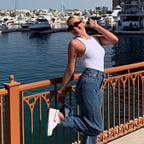Wanderlust — who to trust?
Social media influencers are redefining travel journalism, but have they cast a spell on your travel plans?
What comes to mind when you think of travel journalism? For me, it’s anything from a series of personally written memoirs of people’s travels, their individual experiences transformed onto an online blog or publication, ranked best places to eat or stay in the fashion capitals; to a series of ‘Top Tips’ or advice that title the articles within Travel + Leisure, or Condé-Nast’s Traveller. Almost always, these are accompanied with a carefully selected collection of perfectly edited photographs of sights, views and locations that provoke an overwhelming sense of wanderlust for readers, as well as offering a particular traveller-aesthetic.
However, travel journalism is more than just a glamorised ideal of people’s travels, or what we see on the front page of The National Geographic. Unlike news journalism, travel journalism falls under the category of what can formally be defined as ‘soft journalism.’ Folker Hanush builds upon this, establishing the placement of travel journalism somewhere at the intersection between information and entertainment journalism, as well as advertisement.
Given the era of globalisation and increased mobility that partially led to the recent rise of international travel, there’s no doubt that travel journalism is a fairly modern-day phenomenon. It’s arguable that, social media plays a big part in people’s engagement with the travel industry and journalism, further challenging and restructuring the typical narratives associated with the informational and entertainment form.
In general, Instagram creates an internal sense of ‘I wish that could be’, or ‘I’d love to have their life,’ in regard to the photo-shopped life of influencers. Scrolling through our feed, we constantly see influencers travelling to destinations across the globe, to places like Bali, Mykonos and Ibiza, visiting a number of glamorous restaurants, partying on hired yachts and posing in their designer bikinis on seemingly empty beaches. Ultimately formulating the influencer-traveller aesthetic, which differs from the reality but also offers a new platform for travel providers to advertise via. Why photo-shop their own false reality when influencers can do it for them?
The National Geographic briefly typifies social media fuelled travel, using the example of the small alpine town of Wanaka, New Zealand. In 2015, the international tourism board began inviting specific social media trendsetters with large followings, which led to a 14% increase in tourism growth in the town.
However, in the 5 years since, Instagram influencers have played an even more significant role in the travel industries advertisement strategies. Shows such as, Love Island, have elevated influencer’s celebrity status and in 2020 it was declared by Statista that the Global Instagram influencer market size has increased to an impressive 2.3 billion U.S dollars. So, their influence has undoubtably increased and it’s become clear that when it comes to travel, it’s no longer just travel-specific influencers, but reality TV stars and Youtubers who all fall under the ‘influencer’ category.
‘Mykonos 2020!’ appeared to be the label that titled a vast amount of Youtubers’ vlogs during the short period of summer 2020. Almost certainly, they were accompanied alongside a constant stream of cropped, edited and filtered Instagram posts, capturing their holidays and visits to the infamous restaurants there, such as: Nusr-Et (‘Salt Bae’), Nammos and Nobu.
And so far during the latter half of 2020, it’s more than apparent that Dubai is the seemingly ‘place to be’ amongst social media influencers, Youtubers and reality TV stars. So far we’ve seen names like Molly-Mae, Fearne Mccan, Chloe Ferry, Dan Edgar & Jordan Hames (to name a few), all make their way to the influencer hot-spot, staying in the Five Palm Dubai Hotel, and again, visiting the infamous restaurants there: Nusr-Et, Nammos and Nobu.
Dubai is the posterchild for luxury holidays and superficial lifestyles; a rich-kids playground. Furthermore, the relationship that exists between Dubai and the influencer industry is a clear reinforcement of Dubai’s existing reputation as a destination for consumerism. The performative nature of Instagram itself ties hand-in-hand with the garish connotations that lend themselves to the city of Dubai.
In terms of audience, there’s no doubt that on a daily basis we consume our online feed. Blindly consuming the gifted holidays, unattainable lifestyles, and expensive footwear — falling deeper and deeper into a false reality, and into the trap of consumerism itself.
As a field of journalism, travel journalism has ultimately been redefined by celebrities and influencers to some extent. I’m not saying that Dubai, Mykonos, Ibiza, Marbella, etc. aren’t amazing places to visit, I’m trying to raise the possible implications around this new relationship that exists between the travel industry and social media platforms. Ultimately, influencers are beginning to take on new found roles as travel journalists, almost certainly without them even realising.
It appears that travel-specific influencers and bloggers, and more traditional travel publications such as The National Geographic, are going to have a rapidly decreased impact overtime. Gone will be the days of headlines that read, ‘Top 10 places to visit in Iceland’, ‘My experience of hiking in Patagonia’ or even, ‘How to get an Australian visa’. And our increased engagement with a new form of travel journalism will surround blatant advertisement, superficiality and consumerist destinations. But — where will this leave the rest of the world? And more importantly, how will this impact our worldview?
